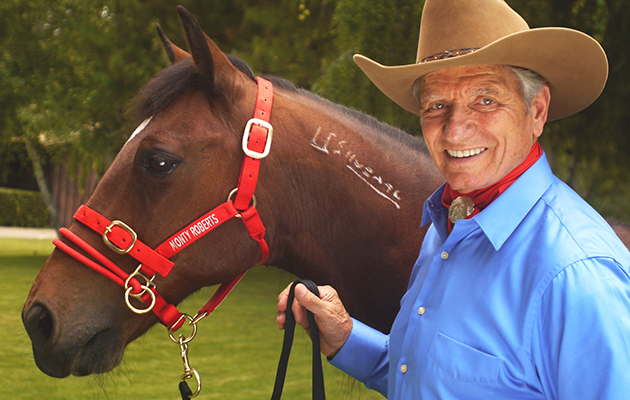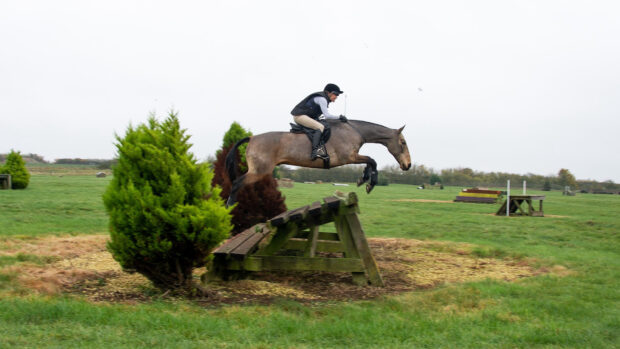Use of a Dually pressure headcollar does not result in more compliant behaviour by horses that have not worn it before, recent research has found. But the headcollar’s designer and founder of Intelligent Horsemanship, Monty Roberts, has hit back saying the halter it has helped him to train some 4,000 horses “labeled impossible to load” to do so.
The study, Dually noted: the effects of a pressure headcollar on compliance, discomfort and stresses in horses during handling by Carrie Ijichi, Shelby Tunstall, Ella Putt and Keith Squibb, published in August 2018, was conducted on 20 privately-owned horses in the UK who had not previously worn a Dually headcollar. The study aimed to determine whether the use of the headcollar improves compliance during handling in horses that had not worn one before, and whether it increases stress or discomfort.
The Dually is a patented training halter, which is described as “effectively rewarding horses for acting in partnership with their handler”.
The study involved horses completing two three-minute handling sessions: one walking over a pole and obstacle and a second walking through hanging streamers. In both tests horses were recorded wearing the Dually with a line attached to the pressure mechanism and with the line attached to the standard ring of the Dually acting as a control test. All 20 horses undertook both tests.
In both handling tests the horse’s crossing time over the obstacle was recorded and the horse’s movement away from the obstacle were recorded as indicators of compliance. Based on this, the study showed that the Dually did not result in more compliant behaviour compared to the control group.
The study found use of the Dually did result in significantly higher horse grimace scale (HGS) scores (used to measure discomfort when pressure was applied), but did not result in a stressed response, measured by infrared thermograpy (a stress measurement indicator which records the core temperature and discrepancy in temperature between a horse’s eyes).
Study author Dr Ijichi, a senior lecturer in equine science at Nottingham Trent University, told H&H the results were surprising.
“I’ve used the headcollar myself for years, I think it’s a very interesting design and potentially a good product. My interest was to measure how effective it was in helping the horse understand what it is what we want them to do and looking at how it effects them emotionally,” said Dr Ijichi.
“We can say it didn’t improve their behaviour on their very first exposure to it, but it doesn’t mean it wouldn’t work in a horse who has previously been trained in how to respond to it.
“With the Dually the HGS scores didn’t indicate the horses were in pain, but it did indicate they were experiencing some discomfort compared to a normal headcollar. The interesting thing is increased discomfort didn’t appear to be enough to cause a stressed response in the horse, which is a good thing.”
Monty Roberts told H&H he would accept a chance to engage with the scientists in a “fair and just test” of the Dually halter.
“The fact is these people have done their best to cast my Dually halter in a negative fashion. However when one completes the findings, the only negative they attempt to justify comes down to subjective equine facial expressions,” said Monty.
“In 30 years I have done approximately 4000 horses which come to me labelled impossible to load. Many are ridden to my venues with stories that would chill one.
“Each owner is told that if I can’t load their horse I have to ride it home. I have not ridden one home and the Dually halter has been the centrepiece of the equipment I use to accomplish the task. Each horse has been worked with for less than 30 minutes and then, when asked, loads in less than five minutes.”

What is a Dually halter and how does it work?
The Dually training halter, designed by Monty Roberts can be used in a number of different situations from leading, loading

Monty Roberts’ Join Up put to the scientific test
British scientists are studying the Join Up training method devised by Monty Roberts

Subscribe to Horse & Hound magazine today – and enjoy unlimited website access all year round
Dr Ijichi said owners shouldn’t look for a “quick-fix” solution in training.
“There is a culture of spending money on a product or aid that will fix the problem we see. People think they can buy an item, put it on their horse and it will magically alter their behaviour,” she said.
“Ideally people will first ascertain whether there is a physical reason or source of pain for the horse acting in an unacceptable way and if that’s not the case look at our behaviour, how consistent we are with them, our timing and the appropriate use of pressure and release, but all of that takes a lot of work and commitment and some people think its easier to buy something that will solve the problem.
“Of course there are aids that can make training more effective, but it’s down to homework at the end of the day. Owners need to think carefully whether you need to purchase an additional device to improve your horse’s behaviour or would you be better to seek the advice of a qualified equine behaviourist.
“If you’re struggling with riding you call a coach and get a lesson, and we need to develop the same culture for problems that we’re having on the ground.”
For all the latest news analysis, competition reports, interviews, features and much more, don’t miss Horse & Hound magazine, on sale every Thursday.





